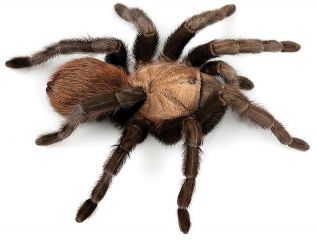Texas Tan Tarantula
The Taxonomy Of The Texas Tan Tarantula
Arthropoda » Chelicerata » Arachnida » Araneae » Theraphosidae » Aphonopelma » Anax
Image Source: Hamilton, C.A.; Hendrixson, B.E.; Bond, J.E. (2016), "Taxonomic revision of the tarantula genus Aphonopelma Pocock, 1901 (Araneae, Mygalomorphae, Theraphosidae) within the United States", ZooKeys 560: 1–340
Physical Description
The Texas Tan Tarantula is a very common companion for those who prefer some of the more exotic pets. The abdomen is generally very hairy and longer haired than the carapace. The color will range from a darker brown to black but may come off as a dingier brown or grey color if they are due for a molt soon. The legs are hairy and black, but may appear more greyish or as a dingy black color, depending on its due time to molt (which typically will occur once a year).
The carapace is the body part in which it receives its common name. The carapace is shorter-haired than the abdomen and legs, and it is also a tan or light brown color. The chelicerae (or spider’s jaws) are also tan/light brown but transition to black at the tips. An adult tarantula will get as large as 10-12.5 cm. The longevity of this arachnid is around 30 years.
Location & Habitat
It is commonly found in Arizona, New Mexico, parts of Texas and Nevada, and southern inland California. The Texas Tan Tarantula has adapted to the arid temperatures but is still more active during the night to avoid the blistering sun. This meaning, they primarily retreat to their burrows during the day. You may come across one during the day, but merely just to find a new burrow or, even better (for a male), a female’s burrow.
Prey & Predators
This arachnid, if you didn’t already know, does not make a web. It depends strictly on its fast movement, odd fangs, larger size, and taking shelter in burrows. Tarantulas in general feed on most any insects, smaller arachnids, and smaller animals than itself such as cockroaches, crickets, scorpions, and even mice.
A tarantula’s fangs are unlike those of any other in the Arachnida class. They move up and down (and even outward) rather than side to side like other arachnids. They inject venom into their prey with the fangs, and the fangs are even used to chew. Predators range from possibly some larger wasps that can give a paralyzing sting to larger birds and animals.
Harmful to Humans?
These, like most all of the tarantula family, are harmless to humans. They can bite, and yes, it will inflict some mild to moderate pain but there has never been any reports or history of anyone dying from this tarantula bite. Most people have compared the bite to that of a bee sting and will only suffer from slight swelling but no long-lasting ill effects. People time and time again, choose this tarantula as a pet though mature males of any tarantula species do not particularly make the best pet in some cases. They have been noted not to live very long because they are solely concentrated on finding a mate. Males are longer, thinner, and have smaller abdomens than females.
Other Names
Aphonopelma anax


